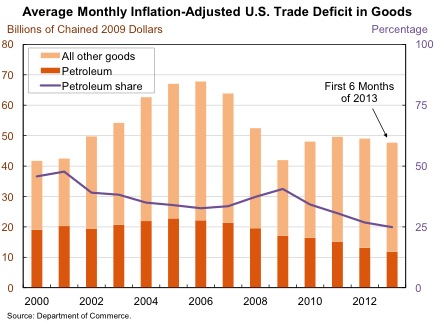
Today the Bureau of Economic Analysis revised up its estimate of second quarter GDP from 1.7 percent to 2.5 percent. This stronger estimate of growth was a result of an upward revision in net exports, with the trade data showing that a key part of the revision is because the trade deficit in petroleum fell to a record low in June. This is yet another reminder that the President’s focus on increasing America’s energy independence is not just a critical national security strategy, it is also part of an economic plan to create jobs, expand growth and cut the trade deficit.
The President established a national goal in 2011 to reduce oil imports by one third by 2020 and elevated the goal in 2012 to reduce them by one half by 2020. We are currently on track to meet this ambitious goal if we continue to follow through on the policies that are critical to achieving it.

There are three basic elements to achieving this goal:
- Increasing domestic production of oil. Government funded research supplemented private industry’s work to develop the technology that sparked the boom in oil and gas production. Crude oil production has grown each year the President has been in office to its highest level in 17 years in 2012 (see chart above). In fact, over the past four years, domestic oil supply growth has accounted for over one-third of global oil production growth.
- Developing substitutes for oil. This includes almost doubling the production of biofuels since 2007 – to a near all-time high – and the substitution as a transportation fuel of oil with natural gas, production of which increased by 25% to an all-time high in 2012.
- Increase energy efficiency to reduce the use of oil overall. With a combination of the stronger fuel efficiency standards and investments in cutting edge technologies, we currently have the most fuel efficient light-duty vehicle fleet ever, and we are working to increase the efficiency of the medium- and heavy-duty fleet as well.
As a result of these changes, in 2012, net petroleum imports had fallen by one-third since 2008 to the lowest level in 20 years. And imports are continuing to fall this year as well. We will shortly be at the point where domestic crude oil production exceeds imports on a sustained basis for the first time since the early 1990s. The increased domestic supply combined with increased oil efficiency of the economy reduces vulnerability to global supply disruptions and price shocks, enhancing our national security.
But among its greatest effects are economic. Every barrel of oil or cubic foot of gas that we produce at home instead of importing from abroad means:
- More jobs. Creates American jobs, adds to our national income, and reduces our trade deficit. Nearly 35,000 jobs have been created over the past four years in oil and gas extraction alone, with more jobs along the crude oil supply chain. North Dakota, for instance, has achieved the lowest unemployment rate in the nation (3.1 percent in June), while developing into a center of the resurgence of domestic oil production.
- Faster growth. Increasing productivity through new techniques and technologies raises national income and increases growth. And improving the terms-of-trade by reducing America’s dependence on foreign oil and increasing our net exports shows up in higher standards of living and also higher growth rates. Most recently, revised net export numbers—including a substantial contribution from petroleum products—played a large role in the upward revision of GDP growth in Q2.
- A lower trade deficit. The oil and gas boom has also substantially reduced the trade deficit. The real (inflation-adjusted) trade deficit in petroleum products fell to a record monthly low in June. The chart below shows that through the first six months of 2013, the petroleum deficit is on pace to set a new annual low this year, after adjusting for price changes. And through June 2013, the petroleum share of the real trade deficit in goods has fallen from over 40 percent in 2009 to 25 percent since then, a pattern that will improve as foreign imports continue to fall and domestic production continues to rise (see chart). Economic news like this is just one more reason for us to celebrate the resurgence of domestic oil and gas production.


